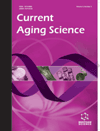- Home
- A-Z Publications
- Current Aging Science
- Previous Issues
- Volume 1, Issue 3, 2008
Current Aging Science - Volume 1, Issue 3, 2008
Volume 1, Issue 3, 2008
-
-
Metabolic Effects of Resveratrol in Mammals - a Link Between Improved Insulin Action and Aging
More LessAuthors: Sara Frojdo, Christine Durand and Luciano PirolaResveratrol, a polyphenol found in several vegetal sources, has been shown to possess lifespan-promoting properties in yeast and metazoans, including small mammals. While in yeast and low metazoans resveratrol acts mainly by activating the histone deacetylase Sir2, in mammals it appears to target - besides the Sir2 homolog SIRT1 - several crucial pathways for the control of metabolism, including the AMPK and the Read More
-
-
-
Melatonin Causes Gene Expression in Aged Animals to Respond to Inflammatory Stimuli in a Manner Differing from that of Young Animals
More LessAuthors: Edward H. Sharman, Kaizhi G. Sharman and Stephen C. BondyGroups of younger and aged mice were fed either minimal basal diet or the same diet containing 40 ppm melatonin. After 9.3 weeks half of each of these 4 groups of animals received either an intraperitoneal injection of lipopolysaccharide (LPS) or of saline. Three hours after this treatment, all animals were killed and mRNA from brains extracted. Quantitative PCR was performed on 13 selected mRNA species reflecting various Read More
-
-
-
Is the Yeast a Relevant Model for Aging of Multicellular Organisms? An Insight from the Total Lifespan of Saccharomyces cerevisiae
More LessAuthors: Renata Zadrag, Grzegorz Bartosz and Tomasz BilinskiThe applicability of the free radical theory of aging to the yeast S. cerevisiae is a matter of debate. In order to get an insight into this question, we studied the reproductive potential (the number of buds produced), reproductive lifespan (the time during which a yeast cell is able to divide), postreproductive lifespan (duration of life of yeast cells which ceased to divide) and total lifespan (sum of reproductive lifespan and post Read More
-
-
-
Possible Links of Age Related Hypertension and Evolution Imposed Features of Heart and Aorta
More LessBy Sven KurbelThe left ventricle thickness is a limiting factor of optimal heart size and strength. Due to disappearance of all the features compromising left ventricular compliance, mammalian heart has decreased vascular density and coronary vessel diameter and it requires sufficient diastolic aortic pressure for the left ventricle perfusion. Atrial muscle and the right ventricle are perfused during the entire heart cycle. The systolic pre Read More
-
-
-
Nanoparticulated Quercetin in Combating Age Related Cerebral Oxidative Injury
More LessAuthors: Sanchari Das, Ardhendu K. Mandal, Aparajita Ghosh, Subhamay Panda, Nirmalendu Das and Sibani SarkarReactive oxygen species e.g. O2.-, H2O2 and .OH generated by the induction of oxidative stress exert a potential threat on the activity of endogenous antioxidant enzymes and substantially influence the aging process and agedependant neuropathology. Chemical antioxidant is almost ineffective in protecting neuronal cells from oxidative damage as Blood Brain Barrier exists in between blood and brain interstitial fluid t Read More
-
-
-
Thyroid Hormone Levels in the Prefrontal Cortex of Post-Mortem Brains of Alzheimer's Disease Patients
More LessConverging evidence suggests a possible link between thyroid state and Alzheimer's disease (AD), including a higher probability of dementia in individuals with higher TSH levels and a two-fold risk of AD in patients with hypothyroidism. Thyroid hormones modulate factors associated with AD, including amyloid precursor protein expression in the brain, suggesting a possible role for thyroid hormone in AD pathology. The present Read More
-
-
-
Human Skeletal Muscle Aging and the Oxidative System: Cellular Events
More LessAuthors: Paola Rossi, Barbara Marzani, Silvana Giardina, Massimo Negro and Fulvio MarzaticoAs we age, the aerobic and functional capacities of our major physiological systems progressively decline. In the case of the neuromuscular system, reductions in strength and mobility cause a deterioration in motor performance and in turn a greater tendency to fall (with increased risk of fractures), impaired mobility, disability and loss of independence in the elderly. Given the increase in our life expectancy and the cons Read More
-
-
-
Interleukin-4-Induced Oxidative Stress Via Microglial NADPH Oxidase Contributes to the Death of Hippocampal Neurons In Vivo
More LessAuthors: Keun W. Park, Hyung H. Baik and Byung K. JinWe investigated the effects of interleukin-4 (IL-4), a well-known anti-inflammatory cytokine, on thrombintreated rat hippocampi in vivo. Intrahippocampal injection of thrombin resulted in a significant loss of hippocampal CA1 neurons, as determined by Nissl staining and NeuN immunohistochemistry. Thrombin-induced neurotoxicity was accompanied by substantial microglial activation, as demonstrated by OX-4 Read More
-
-
-
Prematurely Aged Children: Molecular Alterations Leading to Hutchinson-Gilford Progeria and Werner Syndromes
More LessAuthors: Lourdes Dominguez-Gerpe and David Araujo-VilarAgeing is thought to be a polygenic and stochastic process in which multiple mechanisms operate at the same time. At the level of the individual organism ageing is associated with a progressive deterioration of health and quality of life, sharing common features such as: alopecia and grey hair, loss of audition, macular degeneration, neurodegeneration, cardiovascular diseases, osteoporosis, cataract formation, type-2 diab Read More
-
Volumes & issues
Most Read This Month
Article
content/journals/cas
Journal
10
5
false
en

Most Cited Most Cited RSS feed
-
-
Polyphenols and Aging
Authors: Brannon L. Queen and Trygve O. Tollefsbol
-
- More Less

